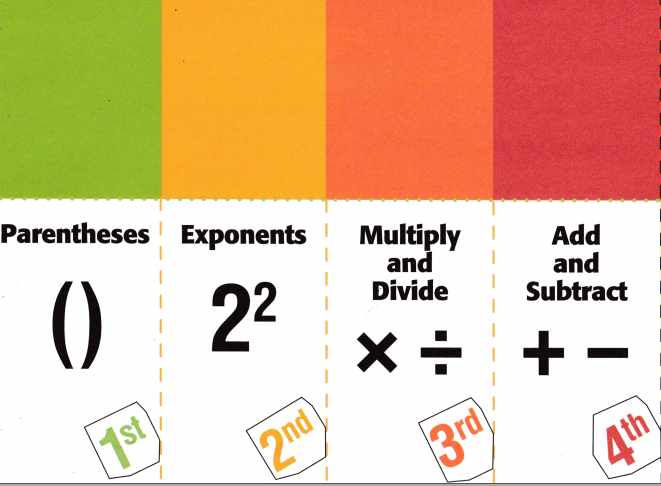All the solutions provided in McGraw Hill My Math Grade 5 Answer Key PDF Chapter 7 Expressions and Patterns will give you a clear idea of the concepts.
McGraw-Hill My Math Grade 5 Answer Key Chapter 7 Expressions and Patterns
Essential Question
How are patterns used to solve problems?
Answer:
One of the problem-solving strategies that is often used in math is to look for a pattern.
Often when exploring problems, the student can notice a relationship between numbers.
This relationship can help to solve the problem by shortening the number of steps it takes to get to a solution.
Am I Ready
Find each missing number.
Question 1.
5 + __________ = 7
Answer:
2
Explanation:
Let the unknown number be x.
5 + x = 7
x = 7 – 5
x = 2
Question 2.
__________ – 4 = 9
Answer:
13
Explanation:
Let the unknown number be x.
x – 4 = 9
x = 9 + 4
x = 13
Question 3.
27 – ___________ = 18
Answer:
9
Explanation:
Let the unknown number be x.
27 – x = 18
27 – 18 = x
x = 9
Question 4.
Devry needed to read 36 pages by Friday. He read 10 on Tuesday and 15 on Wednesday. How many pages does he need to read on Thursday in order to read 36 pages by Friday?
Answer:
11 pages.
Explanation:
Devry needed to read 36 pages by Friday.
He read 10 pages on Tuesday.
He read 15 pages on Wednesday.
Total number of pages read 10 + 15 = 25 pages.
Number of pages he need to read on Thursday in order to read 36 pages by Friday,
36 – 25 = 11 pages.
Question 5.
Quinton struck out 12 batters in his first baseball game, 5 batters in the second game, and 8 batters in the third game. How many batters did he strike out in all three games?
Answer:
25 batters.
Explanation:
Quinton struck out 12 batters in his first baseball game,
5 batters in the second game,
8 batters in the third game.
Number of batters he strike out in all three games,
12 + 5 + 8 = 25 batters.
Identify each pattern.
Question 6.
2, 5, 8, 11 …
Answer:
Rule : n + 3
Explanation:
Each pattern above can be found by adding 3 to the previous number.
2 + 3 = 5
5 + 3 = 8
8 + 3 = 11
11 + 3 = 14
14 + 3 = 17
17 + 3 = 20
Question 7.
4, 9, 14, 19 …
Answer:
Rule : n + 5
Explanation:
Each pattern above can be found by adding 5 to the previous number.
4 + 5 = 9
9 + 5 = 14
14 + 5 = 19
19 + 5 = 24
24 + 5 = 29
29 + 5 = 34
Question 8.
27, 21, 15, 9 …
Answer:
Rule : n – 6
Explanation:
Each pattern above can be found by subtracting 6 to the previous number.
27 – 6 = 21
21 – 6 = 15
15 – 6 = 9
9 – 6 = 3
Question 9.
Antoinette runs each day. What is the rule for the pattern shown in her running log?
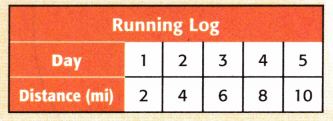
Answer:
Rule : n x 2
Explanation:
Each pattern above can be found by multiplying 2 to the previous number.
1 x 2 = 2
2 x 2 = 4
4 x 2 = 8
5 x 2 = 10
How Did I Do?
Shade the boxes to show the problems you answered correctly.

Answer:

Explanation:
From 1 to 9 questions,
the above are the answers for 1 to 9 questions.
My Math Words
Review Vocabulary
perpendicular
Making Connections
Use the review vocabulary to complete each section of the bubble map.
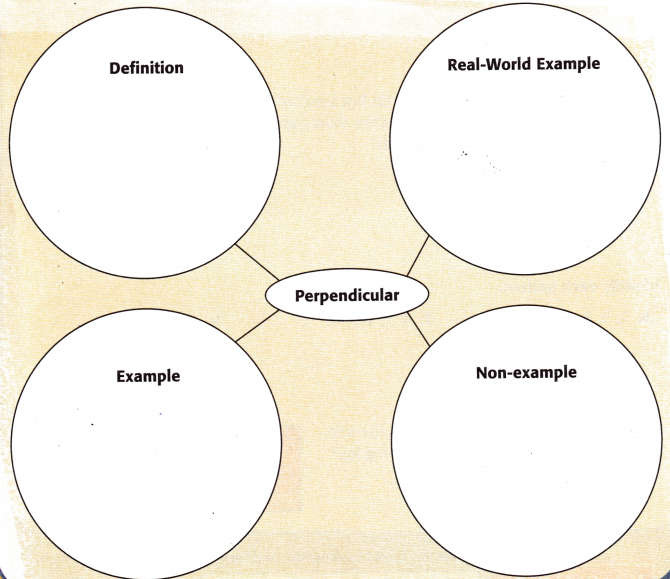
Answer:
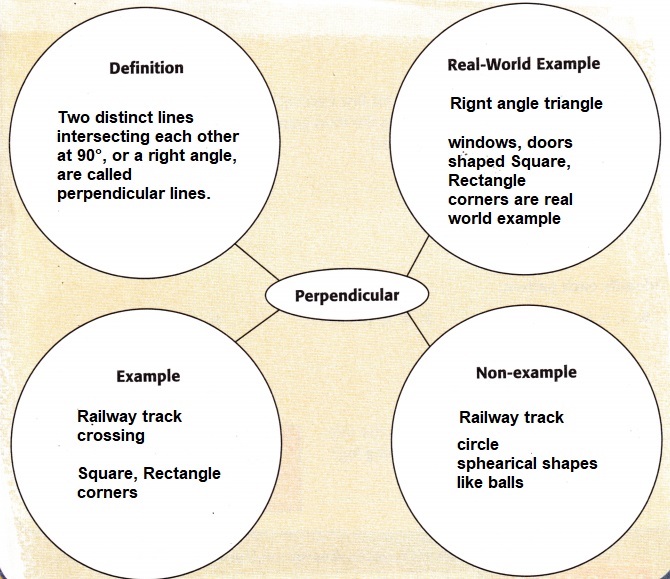
My Vocabulary Cards
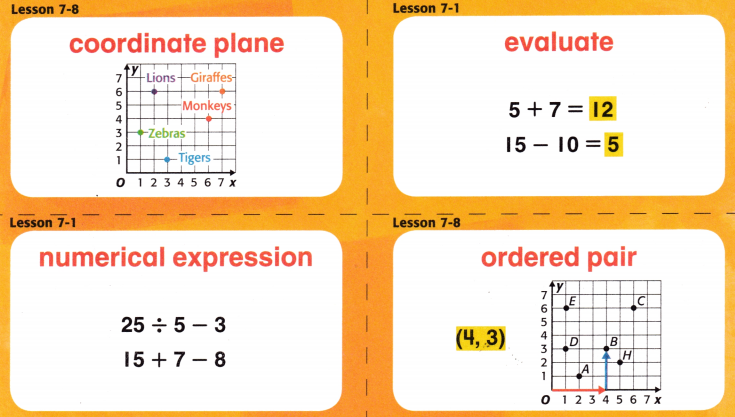
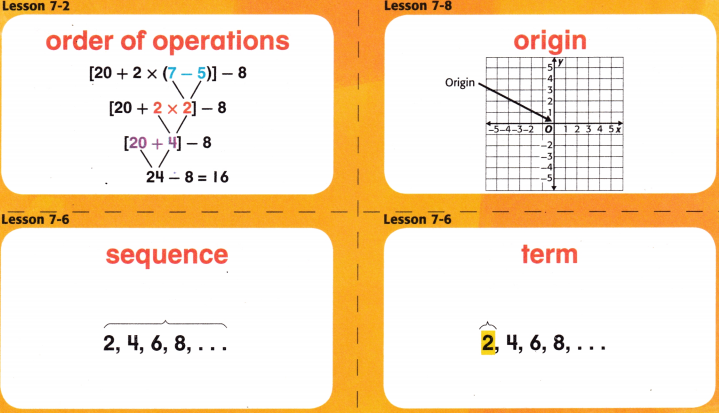
Ideas for Use
- Group 2 or 3 common words. Add a word that is unrelated to the group. Then work with a friend to name the unrelated word.
- Design a crossword puzzle. Use the definition for each word as the clues,
To find the value of a numerical expression by completing each operation.
When evaluating 5 + 3 + 6, does the order in which you add matter? Explain.
Answer:
Associative Property.
Explanation:
In addition or associative property,
if we change the order of addends there is no change in the sum.
5 + 3 + 6 = 14 or 6 + 3 + 5 = 14 or 3 + 6 + 5 = 14
A plane that is formed when two number lines intersect at a right angle.
Describe something you could plot on a coordinate plane.
Answer:
The cartesian plane.
Explanation:
The Cartesian plane is defined as a two-dimensional coordinate plane, which is formed by the intersection of the x-axis and y-axis.
The x-axis and y-axis intersect perpendicular to each other at the point called the origin.
Coordinate System
Vertical Line
Complex Numbers
Real Numbers
A pair of numbers that is used to name a point on a coordinate plane.
Explain how you can remember which number comes first in an ordered pair.
Answer:
A point is named by its ordered pair of the form of (x, y).
The first number corresponds to the x-coordinate and the second to the y-coordinate.
Explanation:
The numbers on a coordinate grid are used to locate points.
To graph a point, draw a dot at the coordinates that corresponds to the ordered pair.
Each point can be identified by an ordered pair of numbers; that is, a number on the x-axis called an x-coordinate, and a number on the y-axis called a y-coordinate.
A combination of numbers and at least one operation, such as 9 – 4.
What is the difference between a numerical expression and an equation?
Answer:
The difference between a numerical expression and an equation is
a numerical expression as a group of numbers and variables with no equal sign.
An equation is a group of numbers and variables that does include an equal sign.
Explanation:
An numerical expression is a group of numbers and variables with no equal sign.
9x – 4 is an expression.
An equation means the two different expressions are connected to each other by an equal to sign in between,
For example, 9x – 4 = 5 + x is an equation.
The point on a coordinate plane where the vertical axis meets the horizontal axis.
Originate is from the same word family as origin. Originate means “to begin.” How can this help you remember the definition of origin?
Answer:
The point at which both x and y equal zero is called the origin of the coordinate.
The origin is the point where they intersect.
This point has the coordinates 0,0 and is usually labelled with the letter O.
Explanation:
The graph shown below explains the terms of Cartesian plane co-ordinates.

The order in which operations on numbers should be done: parentheses, exponents, multiply and divide, add and subtract.
Write a sentence you could use to help you remember the correct order of operations.
Answer:
PEMDAS can be remembered by the phrase “Please Excuse My Dear Aunt Sally”.
Explanation:
In the order of operations, PEMDAS means “Parentheses, Exponents, Multiplication and Division, and Addition and Subtraction”.
Here multiplication and division, addition and subtraction are together.
For example;
2 + 6 × (4 + 5) ÷ 3 – 5.
A number in a pattern or sequence.
Term is a multiple-meaning word. Write a sentence using another meaning of term.
Answer:
Number pattern is a pattern or sequence in a series of numbers.
Explanation:
Number pattern generally establishes a common relationship between all numbers.
A term can be a number, a variable, product of two or more variables or product of a number and a variable.
An algebraic expression is formed by a single term or by a group of terms.
For example, in the expression 4x + y, the two terms are 4x and y.
A list of numbers that follows a specific pattern.
Write a real-world example that is an example of a sequence.
Answer:
A sequence is an ordered list of numbers that often follow a specific pattern or function.
Real world example of sequence is stack of books, cups, chairs and so on..
Explanation:
Sequence help us predict, evaluate and monitor the outcome of a situation or event and help us a lot in decision making.


Answer
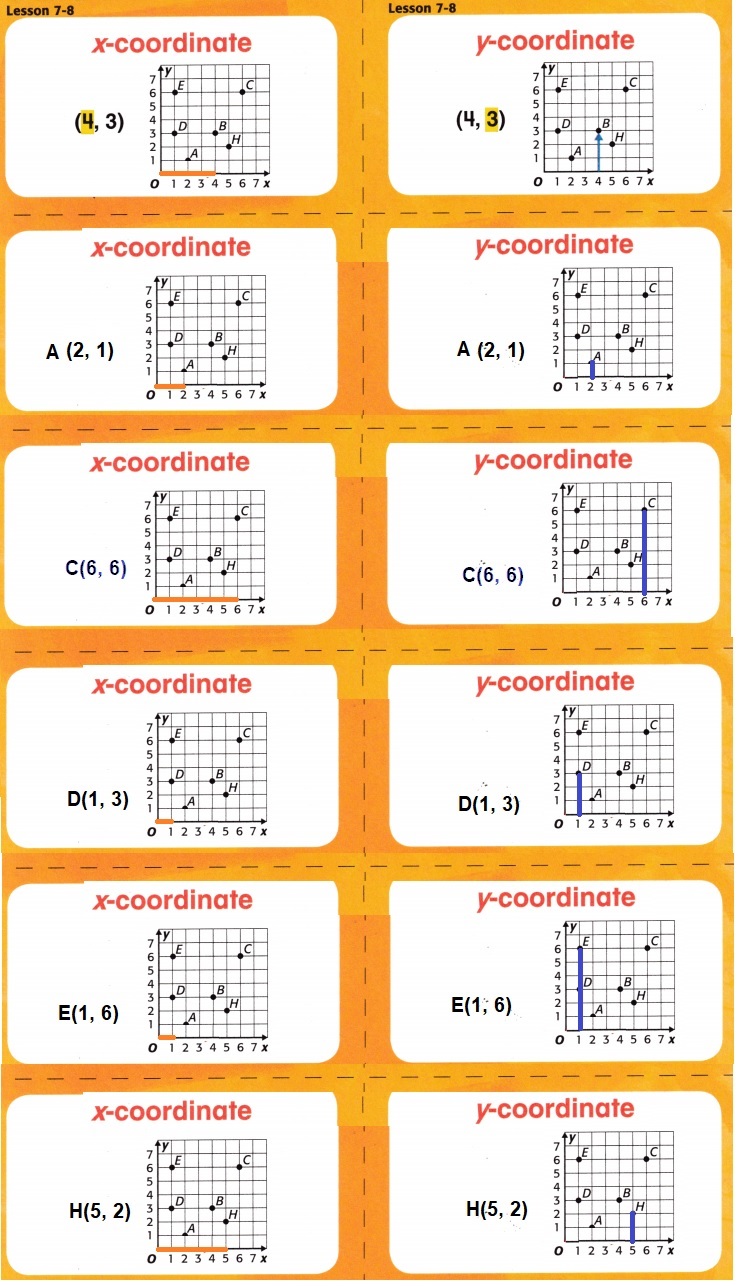
Explanation:
The Cartesian Plane is defined as a two-dimensional coordinate plane, formed by the intersection of the x-axis and y-axis.
The numbers on a coordinate grid are used to locate points.
To graph a point, draw a dot at the coordinates that corresponds to the ordered pair.
Each point can be identified by an ordered pair of numbers; that is, a number on the x-axis called an x-coordinate, and a number on the y-axis called a y-coordinate.
Ideas for Use
- Write the names of lessons on the front of blank cards. Write a few study tips on the back of each card.
- Use the blank cards to write your own vocabulary cards.
The second part of an ordered pair that shows how far away from the x-axis the point is.
In the ordered pair (1, 12), what does the y-coordinate tell you?
Answer:
The Ordinate.
Explanation:
The second number in the ordered pair is called the ordinate.
It takes the value of y.
The ordinate is the distance of any point on the plane from the x-axis.
In the ordered pair (1, 12), y = 12
The first part of an ordered pair that shows how far away from the y-axis the point is.
In the ordered pair (7, 9), what does the x-coordinate tell you?
Answer:
The Abscissa.
Explanation:
The first number in the ordered pair is called the abscissa.
In other words, the value of x in the ordered pair is called the abscissa.
It is the distance of any point on the plane from the y-axis.
In the ordered pair (7, 9), x = 7.
My Foldable
Follow the steps on the back to make your Foldable.
